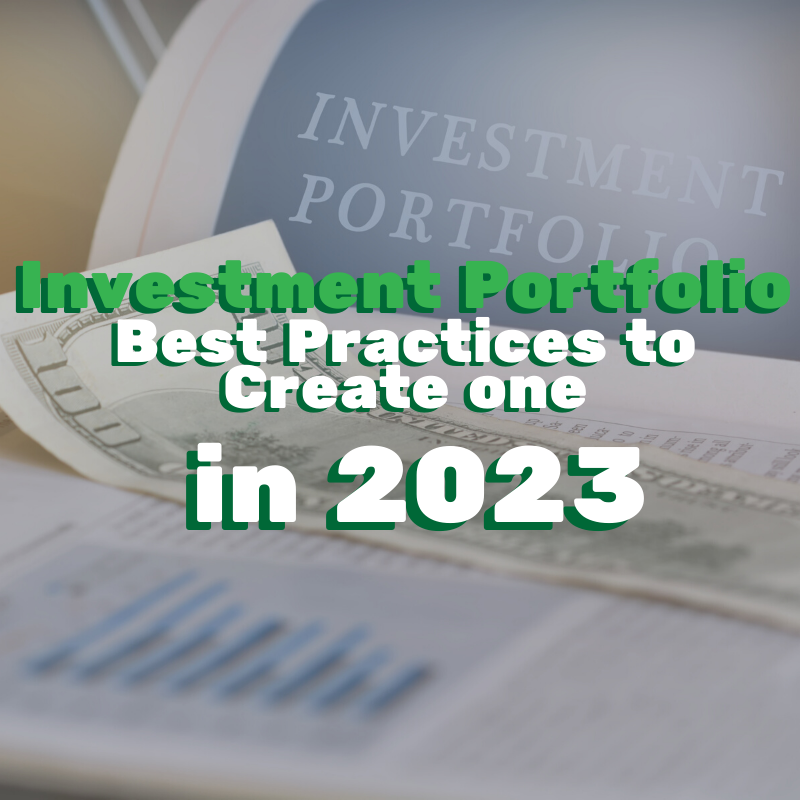Financial, Investment
Investment Portfolio: Best Practices to Create one in 2023
Investing can be an effective way to grow your wealth and achieve your financial goals, but it can also have a significant impact on the environment and society. As a result, more and more investors are looking for ways to build sustainable investment portfolios that align with their values and support positive social and environmental outcomes. In this blog post, we will discuss best practices and tools for building a sustainable investment portfolio in 2023.
What is sustainable investing?
Sustainable investing, also known as socially responsible investing (SRI) or impact investing, is an investment approach that integrates environmental, social, and governance (ESG) factors into financial decision-making. It focuses on generating positive returns while contributing to long-term sustainability and ethical business practices.
This investment strategy prioritizes companies that actively work to reduce their carbon footprint, promote diversity and inclusion, uphold fair labor practices, and maintain high standards of corporate governance. Sustainable investing also encourages businesses to adopt responsible resource management, reduce waste, and minimize their overall environmental impact.
Sustainable investing not only aligns financial growth with ethical values but also contributes to a more responsible global economy. Investors can use ESG ratings and research tools to evaluate potential investments and ensure their portfolios align with their personal and financial goals.
Best practices for building a sustainable investment portfolio
Define your investment goals and values
Before building a sustainable investment portfolio, it is essential to clearly define your investment goals and values. This step helps you align your financial decisions with ethical considerations, ensuring that your investments support causes you care about while also generating returns. By identifying your priorities, you can create a strategy that reflects your vision for both financial success and positive global impact.
Start by asking yourself:
- What social or environmental issues matter most to me?
- Am I focused on long-term financial growth, steady income, or a balance of both?
- Do I want to support specific industries, such as clean energy, ethical labor practices, or fair trade?
- What level of risk am I willing to take in pursuit of my financial and ethical goals?
For example, if you are concerned about climate change, you may want to invest in companies that focus on renewable energy, carbon reduction, and sustainable resource management. If social justice is important to you, consider supporting businesses that champion workplace equality, human rights, and community development. Investors who prioritize ethical corporate governance may seek companies with strong board diversity, transparent reporting, and responsible executive compensation structures.
By setting clear values and financial objectives, you can create an investment portfolio that not only aligns with your beliefs but also positions you for sustainable financial growth.
Conduct research on potential investments
Once you have defined your investment goals and values, conducting thorough research is crucial to ensure your investments align with your sustainability objectives. Researching potential investments helps you evaluate a company’s commitment to environmental, social, and governance (ESG) factors while also assessing its financial stability and growth potential.
Key Factors to Consider:
- Financial Health: Review company financial statements, annual reports, and earnings data to assess profitability, stability, and long-term growth prospects.
- Sustainability Reports: Many companies publish sustainability or corporate social responsibility (CSR) reports detailing their environmental impact, labor practices, and ethical commitments.
- ESG Ratings & Scores: Evaluate companies based on ESG scores provided by reputable agencies such as MSCI, Sustainalytics, and FTSE Russell. These ratings offer insights into a company’s ESG performance relative to industry standards.
- Regulatory Compliance: Monitor how well companies adhere to sustainability laws, environmental regulations, and corporate governance standards.
- Industry Trends & Risks: Stay updated on emerging trends, risks, and innovations within sustainable industries like renewable energy, ethical manufacturing, and green technology.
Tools & Resources for Research:
- ESG Ratings Agencies: MSCI, Sustainalytics, and ISS ESG provide detailed ESG ratings and analysis of companies.
- Sustainable Investment Platforms: Platforms like Aspiration, Betterment, and OpenInvest help investors identify and manage sustainable investment opportunities.
- Stock Screeners: Online tools such as Morningstar’s ESG Screener and Yahoo Finance’s ESG Score can help filter investments based on sustainability criteria.
- Government & Nonprofit Reports: Organizations like the Global Reporting Initiative (GRI) and the United Nations Principles for Responsible Investment (UN PRI) offer reports on corporate sustainability practices.
- Community & Investor Advocacy Groups: Engaging with sustainable investment communities, forums, and advocacy groups can provide insights into responsible investing strategies and ethical companies.
By leveraging these tools and conducting comprehensive research, investors can make informed decisions that align with both their financial goals and their commitment to sustainability.
Diversify your portfolio

Diversification is a fundamental principle of successful investing, and it plays a crucial role in sustainable investing as well. By spreading your investments across different asset classes, industries, and geographic regions, you can minimize risk while maximizing your potential for stable, long-term returns. A well-diversified sustainable portfolio not only enhances financial resilience but also ensures that your investments contribute to various impactful sectors.
Ways to Diversify a Sustainable Investment Portfolio:
- Invest Across Asset Classes: Consider a mix of stocks, bonds, mutual funds, ETFs, and alternative assets to balance risk and returns. For example, investing in green bonds can provide stable returns while supporting eco-friendly projects.
- Explore Various ESG Sectors: Sustainable investing is not limited to renewable energy. Other impactful sectors include clean technology, ethical consumer goods, sustainable agriculture, water conservation, and corporate governance-focused businesses.
- Geographical Diversification: Sustainability challenges and solutions vary by region. Investing in companies from different countries helps spread risk and take advantage of international sustainability efforts, such as Europe’s strong commitment to renewable energy.
- Thematic Investing: Instead of focusing on just one ESG factor, consider a multi-thematic approach. For example, invest in climate action, social justice, gender equality, and waste reduction to create a well-rounded sustainable portfolio.
- Include Sustainable Real Estate & Infrastructure: Green real estate investment trusts (REITs) and companies that focus on eco-friendly infrastructure, smart cities, and energy-efficient buildings can add stability to your portfolio.
- Blend Active & Passive Strategies: While ESG-focused ETFs and mutual funds offer broad market exposure, investing in individual impact-driven companies allows for more tailored and strategic investments.
Monitor and adjust your portfolio
Building a sustainable investment portfolio is an ongoing process, and it is important to regularly monitor and adjust your portfolio as market conditions and your investment goals change.
This can involve rebalancing your portfolio to ensure that it remains diversified, as well as identifying new investment opportunities that align with your values and goals.
Tools for building a sustainable investment portfolio

Robo-advisors
Robo-advisors are digital platforms that use algorithms to create and manage investment portfolios. Many robo-advisors offer sustainable investment options, and can help investors build diversified portfolios that align with their values and goals.
Some popular robo-advisors that offer sustainable investing options include Betterment, Wealthsimple, and Ellevest.
ESG ratings agencies
ESG ratings agencies provide ratings and analysis on companies’ environmental, social, and governance practices. These ratings can help investors evaluate the sustainability of potential investments and identify companies that align with their values.
Some popular ESG ratings agencies include MSCI, Sustainalytics, and CSRHub.
Sustainable investment funds
Sustainable investment funds are mutual funds or ETFs that invest in companies that demonstrate a commitment to ESG factors. These funds can provide investors with exposure to a diversified portfolio of sustainable investments, and can be a convenient way to build a sustainable investment portfolio.
Some popular sustainable investment funds include the iShares MSCI KLD 400 Social ETF, the Vanguard FTSE Social Index Fund, and the Calvert Equity Fund.
Impact investing platforms
Impact investing platforms are digital platforms that connect investors with impact-focused investments, such as renewable energy projects, sustainable agriculture, and affordable housing developments. These platforms can provide investors with opportunities to make a positive social or environmental impact while also earning a financial return.
Some popular impact investing platforms include OpenInvest, Swell Investing, and Lendahand.
Community investing
Community investing involves investing in local communities and businesses, particularly those that are underserved by traditional financial institutions. This can include investing in community development banks, credit unions, or community investment funds.
Community investing can provide investors with opportunities to support positive social and environmental outcomes in their local communities, while also earning a financial return.
Key Takeaways from Gracia
Building a sustainable investment portfolio can be an effective way to align your investments with your values and support positive social and environmental outcomes. By defining your investment goals and values, conducting research on potential investments, diversifying your portfolio, and regularly monitoring and adjusting your portfolio, you can build a sustainable investment portfolio that supports your financial and ethical goals.
There are a variety of tools and resources available to help investors build sustainable investment portfolios, including robo-advisors, ESG ratings agencies, sustainable investment funds, impact investing platforms, and community investing options. By leveraging these tools and practices, investors can make a positive impact with their investments while also potentially earning strong financial returns.
READ MORE RELATED BLOGS!
READ MORE AND SHARE!
TSOK Chronicles: Unleashing Passion, Dedication, and Excellence in 2024
2023 Your Practical Wedding Guide
Investments and Finance Ultimate Guide
If you like this article please share and love my page DIARYNIGRACIA PAGE Questions, suggestions send me at diarynigracia @ gmail (dot) com
You may also follow my Instagram account featuring microliterature #microlit. For more of my artworks, visit DIARYNIGRACIA INSTAGRAM

A multi-award-winning blogger and advocate for OFWs and investment literacy; recipient of the Mass Media Advocacy Award, Philippine Expat Blog Award, and Most Outstanding Balikbayan Award. Her first book, The Global Filipino Bloggers OFW Edition, was launched at the Philippine Embassy in Kuwait. A certified Registered Financial Planner of the Philippines specializing in the Stock Market. A recognized author of the National Book Development Board of the Philippines. Co-founder of Teachers Specialist Organization in Kuwait (TSOK) and Filipino Bloggers in Kuwait (FBK). An international member of writing and poetry. Published more than 10 books. Read more: About DiaryNiGracia

 FREE DOWNLOAD NOW!!!
FREE DOWNLOAD NOW!!!

Peace and love to you.